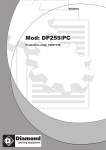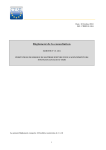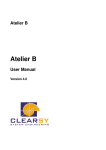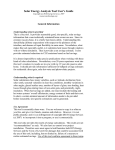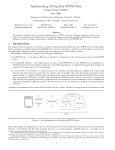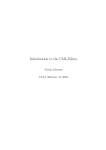Download Projection of HyperPro Document - Ali ED
Transcript
Projection of HyperPro Document
Mariza Andrade da Silva Bigonha
AbdelAli Ed-Dbali 1
Roberto da Silva Bigonha
Flavia Peligrinelli Ribeiro
Pierre Deransart 2
Jose de Siqueira
Universidade Federal de Minas Gerais
Departamento de Ci^encia da Computac~ao
Abstract
HyperPro is documentation and development tool for constraint logic programming systems.
It integrates logic program elements and texts , so it may be viewed as a system for the
development of executable documentation. Projection is a mechanism for extracting and
exporting relevant pieces of code or text according to specic criteria.
Keywords: HyperPro, Constraint Logic Programming, Projections.
1
2
University of Orleans, France
Institut National de Recherche en Informatique et en Automatique{France
1 Introduction
The HyperPro system is a Thot-based documentation and development tool for Constraint
Logic Programming (CLP) systems. It is described in [3]. Thot is a structured editing tool
with hypertext editing facilities. For a presentation of the Thot editor functionalities and
features, the interested reader can refer to the Thot documentation ([7],[9],[8]).
Basic HyperPro documents are stored internally in a tree structure which depends on each
document style dened by the user.
Thot editor oers the possibility to integrate gradually new applications to existing ones,
so the HyperPro system [3] evolved in dierent steps.
In this paper will be dened two newly HyperPro functionalities which are: projections and
exportation introduced in the new HyperPro release of the Thot-based structure, presentation
and translation schemas, called Basic HyperPro [2], which denes a special style for logic
program .
Basic HyperPro aims to document CLP programs giving its users the possibility to edit,
in a homogeneous and integrated environment, dierent versions of programs, comments
about them, information for formal verication and debugging purposes, as the possibility
to execute, debug and test the programs as well. All the attempts and development history
of CLP programs can therefore be integrated and consistently documented within an unique
environment gathering together a hypertext editor, dierent CLP interpreters and syntactical
veriers, as dierent debugging and verication tools as well.
2 Basic HyperPro Document Structure
The Basic HyperPro document is basically a Thot report document. It must have a title, a
sequence of at least one section, a table of contents and a cross-reference index. Optionally,
it can contain the date, the authors' names and their aliations, keywords, bibliographical
references, annexes and a versions index.
In Basic HyperPro a paragraph may be also a relation denition. At least one relation
denition should be present in a Basic HyperPro document.
A relation denition is dened by a relation title, and a list of at least one predicate
denition. The relation title is a predicate indicator, that is, the predicate name and its arity,
or just a name, in which case it denotes a packet of goals or directives, that can be seen as a
special case of relations. The relation title also contains a reference to a predicate denition,
followed optionally by a list of references to predicate denitions that dene dierent versions
of a program.
A predicate denition is formed by three items : informal comments, assertions and packet
of clauses. Informal comments are a sequence of paragraphs. Assertions are a sequence of
lines of text and are optional.
Packets of clauses can be Prolog or CLP(FD) clauses [6]. Clauses include directives, goals,
facts and rules. The predications in the clauses body may have references or not to the
relations which dene them. This will actually dene the current version of a program in a
Basic HyperPro document. At least one predicate denition is obligatory in every relation
denition.
When a predicate denition is introduced, the elds for informal comments and packet of
clauses are initially empty. The optional elds are presented if the user explicitly indicates
so. However, the obligatory elds do not need to be lled in immediately after their insertion
in the document.
3 Basic HyperPro Functionalities and Utilities
The main functionalities provided by Basic HyperPro are views of dierent parts of the
document and indexes associated with dierent utilities, such as program testing and syntactic
verication for some pre-dened CLP and logic programming languages. These functionalities
and utilities are dened in terms of programs versions. In this paper we are interested in
projections and document exporting facilities, the description of the other features can be
found in [2].
3.1 Program Versions
Program versions is an important issue when dening, documenting and developing programs.
Specially when developing and documenting CLP programs, the user needs to dene, test and
document dierent versions of his programs. For that, he may dene for any relation, dierent
versions of its predicate denitions which are documented and managed with the same utilities
used to dene programs. Therefore, a program may have several dierent coexisting versions
which can be dened, named, viewed and tested as much as any program. Indeed, program
versions are programs which dier at least in one clause.
3.2 Dening Program Versions
Whenever a program is dened and the user changes the current predicate reference of a
relation composing it to point to another predicate denition, the user is dening a (new)
program version. This is the simplest way to dene a program version. However, to complete
the denition the user has to insert program reference in the predications at the body of the
current predicate denition and then name it. This is done with the naming utility. Note
that, although the current predicate reference changed for the relation the user modied, all
the named reference which pointed to the previous current predicate denition still dene the
corresponding programs. It is only a new version that is being dened and named, and all
previous programs depending on other predicate denitions for this relation are still properly
dened.
3.3 Document Exporting Facilities
HyperPro allows the user to export the whole document in two dierent formats: ASCII and
Latex [5]. The new release of HyperPro, the Basic HyperPro, included HTML in their facility
list.
The ASCII exporting facility simply makes a dump of ASCII codes of the document into
a le.
The Latex exporting facility dumps a Basic HyperPro document into a le in Latex format.
The logical structure of the original document is entirely reected in the Latex le, except
for the hypertext links, for obvious reasons. However, the indexes are mirrored in the Latex
document, so that the hypertext version of the original document is faithfully rendered in
paper, as much as possible.
The HTML exporting facility translates the original Basic HyperPro document in such
way to be viewed by any available web browser, where the original hypertext links appear
as such in the HTML version of the document. It is available to the user the possibility
to translate their document into two html version, one consisting of a unique le or a html
version with multiles. However, the logical structure of the document division in dierent
unities such as chapter, sections and subsections is not maintained, and only the unities titles
appear in the main HTML document in the case of multile. Neither is translated in the
HTML export of a HyperPro document the table of contents or indexes.
3.4 Indexes
Thot provides an index utility which allows the user to dene dierent indexes. To create an
index, the user inserts manually pairs of marks around the word or words he wants to appear
in the index. After this is done, for all words he chooses, the user creates the corresponding
index through a Thot menu.
Based on this utility, Basic HyperPro provides the user with two dierent indexes: Crossreference index, and Index of versions.
The cross-reference index indicates where a relation appears in the document, where is
found its current predicate denition and where the relation is used in other parts of the
programs dened in the document, independently of program versions. It is an absolute
index of relation denitions.
The cross-reference index will be created automatically. This means that pairs of indexes
marks should be put automatically around predicates everywhere they appear in the clauses
entered. Once this is done, the user can create in an usual way the cross-reference index.
This facility is not yet available, it is being implemented.
The index of versions shows where versions are rstly dened, i.e., where in the document
is found the predicate denition pointed by the rst named reference appearing in the document, as all corresponding predicate denitions pointed by named reference for each relation
included in the program or version as well. Modications in the version, i.e., version deletion
or additions to it should be mirrored in the index. But this is not automatically done by
Basic HyperPro, since index construction in Thot depends entirely on the user to put the
pairs of marks around the parts he wants to appear in the index.
3.5 Views of the Document
Thot allows the user to dene views of his document, such that, chosen portions of it are
presented separately in a view. Views are synchronized in such a way to facilitate selecting,
moving and editing consistently and easily in a particular view as much as in the main view.
In addition, any operation in a view are reected in all the others. Also, we provide in Basic
HyperPro the possibility to project and view separately some parts of the document selected
by the user following some criteria, this is called projections [1], [2].
Basic HyperPro provides several dierent views of the same document: the main view
of the whole document; view of the table of contents; view of the comments; view of the
assertions; view of the packets.
The main view and the table of contents are displayed automatically, when a document
is opened. The main view shows all the document as it is dened by the user, and while he
denes it. It contains all the subsections, sections and chapters dened, with all the relations
denitions and versions references. The table of contents displays all the subsections, sections
and chapters dened in the document and their references, such as their ordering number and
page.
The views of comments, of assertions, and of packets are shown on demand by the user
through the appropriate Thot menu bar. Each view displays all and only the comments, or
assertions or packets dened in the document.
3.6 Projections View
A projection view displays selected portions of the document in a separate view. The selection
process depends on the projection wanted. Projections dier from pre-dened views on the
selection process. Also, views are static and are already incorporated in Thot's machinery,
the projections are dynamic and are provided by Basic HyperPro.
The Basic HyperPro oers ve dierents projections views: manual projection, recursive projection, regular expression projection, version projection and index based projection.
There are two dierent indexes based projection view, one of them is produced from the Cross
Reference Index (CRI) of predicates and the other one is produced from version index.
In the manual projection view the user is free to select any part of the document to be
viewed.
In the recursive projection view, the user can choose one or more relation denitions and
the Basic HyperPro will show in a separated view all the packet of clauses related to that
relation including the current predicate and all the predicates referenced in the chain which
the relation is inserted.
In the regular expression projection view, the user gives some regular expression and
Basic HyperPro shows in a separate view all the portions of the document where the regular
expression appears.
The version projection view shows, in a separate view, all the packets of clauses composing
a version of the program chosen by the user in the document.
The index-based projection view should allow the user to select any index entry and have
all the correlated parts of the document shown in a separate view.
4 Basic HyperPro Facilities and Utilities Interfaces
In this section we present the user's schematic interfaces such as menus and sub-menus for
the functionalities and utilities that have been present in Section 3. Some functionalities and
utilities appear in specic Thot menus, like the export, views and index facilities. However,
the manual and regular expression projection view, the version view, the recursive view and
the index-based projection views facilities appear in the Thot's Tools menu, as the others
utilities as well. The reason is that Thot allows anyone to include his own facilities using the
Thot toolbox, which are accessible through the Tools menu.
Views are selected in the Thot menu Views. There the user chooses the entry point to the
sub-menu Open a view... and in there, he chooses the view he wants to open. The views the
user can open are, therefore: text view; view of the table of contents; view of the program;
view of the comments; view of the assertions; view of the types; manual projection view;
manual projection view; recursive projection view; regular expression projection view; index
based projection view; version projection view and notes view.
The exporting facilities are accessed by the Document menu, and the Save as... sub-menu.
A window opens where the user can then choose the exporting facility he wants to use, Thot,
ASCII, Latex, Html, RTF.
We will not present here the index utility interface. The reader can nd about it and how
to use this facility in the Thot User Manual ([9]).
4.1 Tools Menu
Thot's tools menu oers the user access to the following utilities:
Other Thot usual menu entriesi Tools
h
Make indexes
Versions
Projections
Tests
Sintax verication
HyperPro preferences
>
>
>
>
>
Manual
By relation (recursively)
By regular expression
By version
By Index based
All utilities interface is done through communications windows, where the user controls
the utility and where the data input is done, and some utilities may open a specic window
to work as their output interface.
In the following sections we describe for each projection its dialog box if it exists.
4.1.1 Manual Projection Dialog Box
To use the manual projection when the user clicks on it, a dialog box like the one presented
in Figure 1 appears with the buttons: select, delete, cancel and done, where:
select) selects part of the document to be shown.
delete) deletes an element from the projection view.
cancel) cancels the projection view.
done) closes the dialogue box and the projection view remains.
Create manual projection of the document
select
delete
cancel
done
Figure 1: Dialog Box of Manual Projection
To include an element in the projection, the user should select that element with the
selection button and automatically it will appear in the Manual projection view. It is
allowed to include several elements in the same view. The user can do that by pressing the
selection button again.
To include an element in another view, the system will automatically close the current
projection view and open another one with the newly element.
To delete an element, press the delete button and click on the element to be deleted. The
element will be deleted but the view remains open because the user may want to keep the
others elements in the view, if they exists.
4.1.2 Recursive Projection Dialog Box
The recursive projection that is available to the user attaches the attributes to the entire
relation denition so it doesn't need a dialogue box.
To execute the recursive projection in this current version, the user has to click on the
menu Tools, Projections and then, By relation (recursively). Clicking on that, a
small hand appears in the Basic HyperPro document. After that, the user has to choose one
relation denition in the document and click on it. The Recursive projection view will
open automatically with the relation denition selected and all the relations which are related
to it.
We are working in the new version of this projection to allow the user choosing between
the entire relation denition or only in the predicate of the relation.
The dialog box for this new version is presented in Figure 2. In this dialogue box, the
button CPR will be used to attach the attribute on relation title, and the target of CPR. The
button All will be used to attach the attribute relation denition. Actually All represents
the current implementation of the recursive projection.
Create recursive projection of the document
CPR
ALL
Figure 2: New Dialog Box of Recursive Projection
4.1.3 Regular Expression Projection Dialog Box
To use a regular expression projection it is available a dialog box like the one presented in
Figure 4, where the functions are:
Search for) the word to be searched and displayed in the projection.
go) nds the word which is to be searched.
select) include the element which the word is inserted in the projection.
cancel) to cancel the projection.
In this dialog box we choose a word from the Basic HyperPro document typing it in
the box bellow Search for. It is available four options to direct the user in nding the
occurrence of the regular expression in the document: after the word selected, before it,
inside a denition selected or in the entire document. By default it will be always selected
after the definition selected.
4.1.4 Version Projection Dialog Box
The version projection does not need a dialog box. When the user calls this function, a
message appears on Basic HyperPro's main window, presented in Figure 4, showing the user
Create regular expression projection from the document
Search for
word
Before selection
Within selection
After selection
In the whole document
Select
Go
Cancel
Figure 3: HyperPro Main View
what to do.
To use version projection the user needs to select the menu Tools, Projections, and By
version. After that, the user have to click on a version and it will automatically be open in
the Version projection view.
hyperpro
File Environment Palete Help
Thot
click on a version name
Thot@INRIA
Figure 4: Dialog Box of Version Projection
4.1.5 Index-based Projection Dialog Box
The dialog box for this projection looks like the one showed in Figure 5:
Select index entries
OK
Cancel
Figure 5: Dialog Box of Index Based Projection
The user clicks on index entries until \OK", then the view is opened.
5 Projections View Implementation
To implement the projections presented in Section 3.6 we had at least two ways to do it. The
rst one, which is a non trivial solution, consists of adapting a copy of a function from the
Thot's Library to our needs and incorporating the modied version in the library.
The second one consists of adding in the Basic HyperPro structure a global variables
attribute, and then add in the presentation le of Basic HyperPro a view to have a projection.
The presentation of Basic HyperPro document may be programmed by means of P language [10], and for the view projections of HyperPro, the control of visibilities had to be
encoded into the presentation schema as it is described in the sequel. The presentation rule
of the visible attribute must have a visibility which must be bigger than the sensibility of
Projection view. To make an element visible in the Projection view, it is necessary to attach
it to the visible attribute. This solution is easy to implement but presents two drawbacks:
1. it is related with the modication of the structure schema. If the structure and presentation schema is changed, some problems in opening old documents will appear. Besides
that, from the user point of view, this is uncomfortable.
2. It is necessary to declare, in the presentation schema, n views for n kinds of projections or
any dynamically opened views. Another problem is that we can not have simultaneously
two instances of the same kind of view. For instance, we can not have two projection
views on dierent versions.
We have chosen to implement the rst option thinking that it would be better because
we did not have to make any changes in the structure and presentation schema, which should
be frozen by this time. But it did not work because it is hard to understand and modify the
Application Program Interface (API's) code [4]. So, we have chosen to implement the second
option.
In order to implement this option, we made some changes in the structure and presentation schemas. In the structure schema, we included ve variables representing the visible
attributes, one for each projection presented in Section 3.6.
In the presentation schema we included the declaration of ve views in the section where
views were declared corresponding to the ve projections presented in Section 3.6. Set the
Basic HyperPro visibility to zero in those views and, at last, set the attribute with sensibility
eight for each view.
After these modications had been included in the Basic HyperPro schemas, we were able
to start implementing the projections.
In the following sections we describe for each projection its functionality and implementation.
5.1 Manual Projection
The manual projection is a dynamic view in which the user can work with selected element.
In this projection, the user can select several parts of the document, called elements, and
these elements will be shown in a separated view. The granularity of the selected element
is dened to be paragraphs and relation denition. Therefore, when the user clicks in any
of these elements or in their descendants, the projection will show the whole paragraph or
relation denition.
To implement the manual projection we rst get the clicked element, next we check if the
clicked element is a paragraph or a relation denition traversing the abstract Basic HyperPro
structure tree. Otherwise we verify if the element has already an attribute, if not, we create
a new attribute and attach it to the element.
Shortly, to include an element in the projection view is the same as to attach an attribute
to this element, and to delete the element from the projection view is the same as to remove
the attribute from the element.
The manual projection view for the n-queens problem is showed at Figure 8. In this example, the output of manual projection possesses two paragraphs and one relation denition.
5.2 Recursive Projection
In the recursive projection view, the user can choose one or more relation denitions and
the Basic HyperPro will show in a separated view all the packet of clauses related to that
relation including the current predicate and all the predicates referenced in the chain which
the relation is inserted.
The recursive projection view is useful for helping the user to detect which predicates have
not yet its predicate reference set or to nd out where it is set to.
The recursive projection available to the user attaches the attributes to the entire relation
denition so it does not need a dialogue box. This projection works as follow: when the user
chooses a relation, the projection nds out all the others relations denitions which is related
to it, traversing the Basic HyperPro structure tree, and then attaches the attribute to them.
In the implementation of this projection, it was also used the Thot library to deal with
lists. The list contains all the referenced predicates, it starts building the list of relation
denitions that must be in the projection, nd the denitions references in the packet of
clauses and put them into the list. The library's functions used are those: to add an element
to a list, to delete an element from the list, and to destroy the list.
In order to complete the implementation of recursive projection the next step is to implement a function to allow the user choosing between selecting the entire relation denition or
only the current predicate of the relation. Figure 9, at the end of this document, shows an
example of recursive projection view for the n-queens problem.
5.3 Regular Expression Projection
The regular expression projection is a view facility where the user can give a regular expression
and as a result Basic HyperPro will provide in a separate view all portions of the document
where the regular expression appears. The smallest granularity for this projection is a word.
To implement the dialog box for this projection we use one adaptation of the function
Search which is in the menu edit of Thot. The function to search the regular expression works
as follow: when it nds the string, it attaches the attribute to the element.
5.4 Version Projection
The user can, in the version projection, to select a version to be viewed in a separate view.
This view will contain all the packet of clauses composing the version chosen.
The version projection algorithm was implemented in the following way: verify if the user
had clicked in a version name or not, if so, from the main root of Basic HyperPro structure
tree search for every time the version selected appears, returning the root element of the main
abstract tree. After nding the places where the versions appears, nd out the places where
the reference is pointing to and attach the attribute to that element.
5.5 Index Based Projection
In this projection view, the user will be able to select any index entry and have as a result
all the correlated parts of the document shown in a separate view. There will be two kinds
of index based projection: the projection produced from Cross Reference Index (CRI) of
predicates explained in Section 5.5.1 and the projection produced from version index explained
in Section 5.5.2.
5.5.1 Index Based Projection Produced from CRI of Predicates
In this index based projection, the user will choose a predicate denition from the Predicate
Cross Reference Index and the Index Based (CRI) Projection will show, in a separate view, the
current predicate of the denition and every denition that it appears. CRI means Current
Reference Index.
The Figure 6 presents the skeleton of this projection. Here, pdu means predicate denition
and use. This projection is implemented in the same way as recursive projection. The
dierence between than is related to the place the user clicks on the predicate. In this case, it
clicks on the predicate cros reference index view instead of the hyperpro document as in the
recursive projection.
Predicate cross reference index
p/1
page
HyperPro Document
p/1
r/3: pdu
q(x,y)
q(x)
q/2
p/1: pdu
pdu
page
r(x,y,z)
q(x.y)
r/3: pdu
q/2
Click on
p/1
Index Based (CRI) Projection
r/3
q(x,y)
begin from p/1 as in
p
def
recursive projection
q/1
Figure 6: Scheme of Index Projection produced from CRI of Predicates
5.5.2 Index Based Projection Produced from Version Index
For the index based projection the user needs to have the version index. This view contains
the versions for each predicate dened in the document, including the page number where
they have appeared in the Basic HyperPro document. From this index he will click on a
version. After that, Basic HyperPro will provide automatically in a separate view, as showed
in Figure 7, the Index based projection VI, all the predicates of the chosen version. VI means
Version Index. This projection is implemented in the same way as version projection. The
dierence between than is related to the place the user clicks on the version. In this case, it
clicks on the version index view instead of the hyperpro document as in the version projection.
Figure 7 presents the skeleton of this projection.
Version Index
Basic HyperPro Document
version1: p/1 page ..., q/1 page
p/1 version1 version2
version2: p/1 page .., r/2 page
q/1 version1
click from
(on version1)
r/2 version2 version3
Index Based Projection VI
p/1
q/1
Figure 7: Scheme of Index Projection produced from Version Index
6 Conclusion
HyperPro is a documentation development tool for logic programming systems. It oers
several facilities to view and handle documents at dierent levels of abstraction and from
dierent point of view. Particularly, HyperPro aims to document CLP programs giving its
users the possibility to edit, in a homogeneous and integrated environment, dierent versions
of programs, comments about them, information for formal verication and debugging purposes, as the possibility to execute, debug and test the programs as well. All the attempts
and development history of CLP programs can therefore be integrated and consistently documented within a unique environment gathering together a hypertext editor, dierent CLP
interpreters and syntactical veriers, as dierent debugging and verication tools as well.
It also possesses several functions for exporting the document in dierent formats such as:
html, latex, ascii, and producing projections, which are especial excerpts of the document,
according to dierent criteria, such as, the program goal, pieces of code directly marked by
the user, program versions, etc.
In this paper we have presented the implementation results of the projections views which
are manual projection, recursive projection, regular expression projection and version projection. The index based projection is under development.
References
[1] Peligrinelli, Flavia, Bigonha, Mariza A. S., et all, \Um Ambiente para Desenvolver Programaca~o em Logica Baseado no Paradigma do Estilo Literario", Trabalho selecionado
para o Primeiro Lugar na area de Ci^encias Exatas e da Terra durante a 7a Semana
de Iniciac~ao Cientca. Publicado nos Anais de Resumos da 7a Semana de Iniciaca~o
Cientca da UFMG, pagina 204, 1998.
[2] Pierre Deransart AbdelAli Ed-Dbali Mariza A. S. Bigonha Roberto S. Bigonha Jose
de Siqueira, \Basic HyperPro Functionalities and Utilities", Relatorio Tecnico 023/97,
Departamento de Ci^encia da Computaca~o, UFMG, dezembro de 1997.
[3] Deransart, P., Bigonha, R., Parot, P., Bigonha, M., Siqueira, J. de, A Hypertext Based
Environment to Write Literate Logic Programs, I Congresso Brasileiro de Linguagens de
Programac~ao, Belo Horizonte, 4 a 6 de setembro de 1996.
[4] Quint, V. and Vatton, I., The Thot Kit API, INRIA Rocquencourt, technical report,
July,10, 1997.
[5] Lamport, L., Latex : A Document Preparation System, Addison-Wesley Publishing Company, 1986.
[6] M. Bergere and G. Ferrand and F. Le Berre and B. Malfon and A. Tessier, La Programmation Logique avec Contraintes Revisitee en Termes d'Arbre de Preuve et de Squelettes,
LIFO, Orleans, 1995, LIFO 96-06, February.
[7] Quint, V. and Vatton, I., Grif : an interactive System for structured Document Manipulation, Proceedings of the International Conference on Text Processing and document
Manipulation, 1986, November, 200-213, Cambridge University Press.
[8] Quint, V. and Vatton, I., Hypertext aspects of the Grif structured editor : design and
applications, Rapports de Recherche #1734, INRIA Rocquencourt, 1992, July.
[9] Quint, V., The Thot User Manual, Internal report, INRIA-CNRS, 1995.
[10] Quint, V., The Languages of Thotl, Internal report, INRIA-CNRS, translated by Ethan
Munson, version of June 25, 1996.
Figure 8: Output of Manual Projection View
Figure 9: Output of Recursive Projection View















